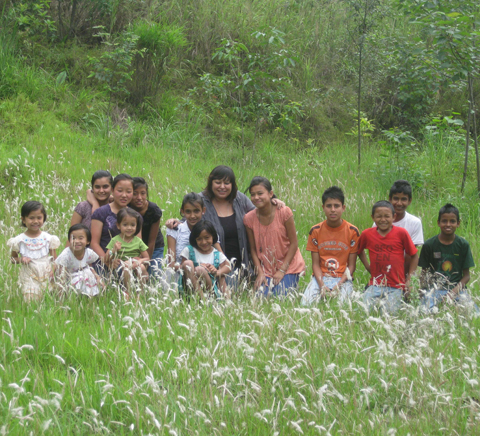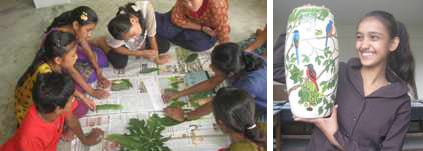For 11-year-old Saroj Sharma – fondly known as Nanu Bhai – it is a luxury to attend the art school in his remote village Pudung near Kalimpong in West Bengal. His hands and feet look and feel like one of a 30-year-old labourer, with cuts, grazes and blisters. He goes out at the crack of dawn to cut grass, and to graze his cows and goats.
But look into his eyes and you know that he is a child. Give him colouring pencils and paper and you will see him sitting quietly in a corner, not removing his eyes from his work – with a huge smile on his face.
“He is prolific with his artworks – producing one after another. It almost feels like he is making up for his lost time. He amazes me with his intimate knowledge of the local trees and plants,” says botanical illustrator Hemlata Pradhan, founder of the Himalayan Institute of Natural History Art (HINHA) in Kalimpong, in the mountainous Darjeeling district of West Bengal, India.
Pradhan paints orchids and other plants. In her institute, she has a passionate bunch of rural children who dream of combining art, education and conservation at the grassroots.
Celestina Lepcha, 14, from the same village, is now inspired to be a natural history illustrator, work in natural history museums or botanical gardens. She has become very observant about nature.
“In the past, while cutting grass and collecting firewood in the forests, we used to come across a lot of insects and plants which we used to brush off as just something which we saw every day. Today, these very life forms have so much information in them and I find myself documenting as many of them as possible during my free hours. This practice has helped me bond with the natural world and has taught me compassion and reverence for nature,” says Celestina.
Pradhan has high praise for Celestina, whose parents live away from home. Her father is a carpenter and her mother works as a labourer in a school. They come home once a month. Celestina lives with her sister who is just a year older – they literally look after themselves. She loves the art school like her own home. “She is one of the best botanical art students we have and as she is very observant, she knows a lot about natural life. Her dream she says is to study live snakes one day. In the meantime, she is happy drawing plants and birds,” says Pradhan.
The teacher recalls a day when Celestina came from school all flushed with excitement. “She told me that she had seen a giant bird on a fig tree near her school. The very next day I could see all the children shouting with excitement outside the art school as they saw a huge bird sweeping past the school building. It was the Great Indian Hornbill. It was a rare sighting. It was the same bird Celestina had seen on the fig tree eating the fruits. Documentation of such experiences in the form of art and writing by children are prolific, fun and easy for even a layman to understand.”

The start
HINHA grew out of the Himalayan Trust for Natural History Art which was started by Pradhan in 2003. The trust now sponsors and looks after the art education of 14 children between the ages of 7 and 14 years, all residents of villages nearby. They attend regular school during the day, then the art school in the evenings, weekends and every major holiday.
It had not been an easy school to start. These children had not touched colouring pencils before. They were unaware of something called the art world. Moreover, their parents did not want them to learn art, which the parents saw as a waste of time when the children could help around the house or do odd jobs.
In response, Pradhan made three rules. First, leave all your worries and problems at the gate, don’t bring the baggage in. Rejoice in being here and just enjoy creating and having fun in the process. After class, we can discuss your problems and see if we can come up with solutions together. Second, promise to maintain your diary and sketchbooks with respect and dedication. Third, it is compulsory to complete all your regular school assignments, studies and other home chores before you can sit down with art.
Pradhan says, “The third rule, in fact, was incorporated much later when I found out that the children had actually started to intentionally miss regular school and home chores in order to be at the art school. This was proof enough that they enjoyed being at the art school but we did not want any trouble from their regular schools and parents.”
Learning from nature
At the beginning of each new session, the children are presented with diaries and sketch books. It is mandatory for them to create field drawings and sketches and note down their observations and thoughts every day. They even carry them to their regular schools and work during lunch breaks and any free hours they get during the day. This routine has taught them the importance and value of time and of finishing their chores.
Pradhan says children are inquisitive, curious, open minded and natural researchers, and the diary allows them the freedom to “discover and learn” by themselves.
The art school gets visiting tutors, all professionals in their own fields who share a love for the natural world. The children are taught how to make close observations of nature and document them in the form of sketches, paintings, doodles, words, maps, dance, poems, songs and so on, using traditional techniques. They are also taught how to be innovative and versatile with their drawings and are encouraged to try different styles, techniques and mediums. Educational field trips form a vital part of the curriculum.

Their knowledge of the natural world and their surroundings come from the daily chores like cutting grass and collecting firewood from the forests. You ask them about “jungle medicines” and they will give you a list for broken bones, headache, jaundice, fever, high blood pressure, diabetes and other ailments. Ask them about birds and insects and they know exactly where and how these animals live and what they eat. “What we have added to their knowledge is the power of closer observation through the classes,” says Pradhan.
Four years down the line, the art students have metamorphosed into more responsible children. Pradhan recalls an incident when two of her students Sumrita Gotamay, 14, and Pushpakala Sharma, 15, came to class with a whole bunch of orchids which looked dead except for a few struggling leaves and roots. The children told Pradhan that while cutting grass in the morning, they had found a fallen tree with the bunch of orchids on it.
Just two weeks before that, they had had classes on salvaging plants and animals in distress. Now the students told Pradhan they felt sorry for the dying plants, wanted to salvage them and could they be allowed to plant them on one of the trees at the school? The teacher agreed on condition that if the orchids managed to flower and bear seedlings, they should be taken back to the place where they had been found. The students tied the bunch to a tree and have been monitoring its progress.

Pradhan says, “My aim is to train and promote talent in the fields of natural history art and ecological studies so that these children and others explore and hone their talents further, while training to combine the highest standards of artistic excellence with a deep respect for and the understanding of the natural environment. It will also help provide a sustainable future for them.”
